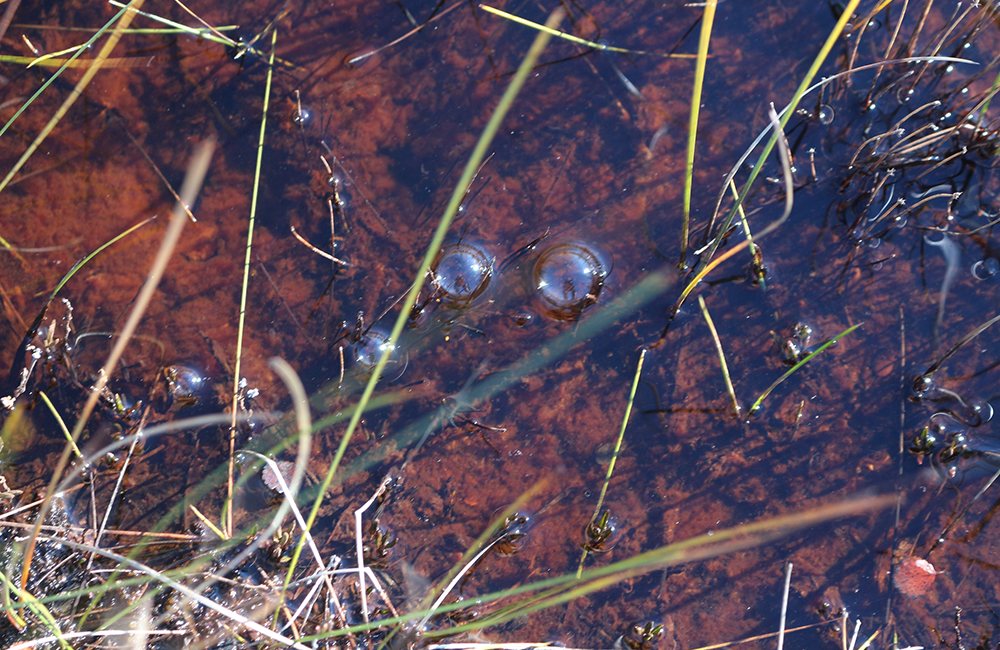2022-12-14 オークリッジ国立研究所(ORNL)

Iron content gives a reddish hue to an area of ponded water in the Arctic permafrost. ORNL scientists are exploring the importance of the iron cycle on how greenhouse gases are released from thawing Arctic soils. Credit: David Graham/ORNL, U.S. Dept. of Energy
研究者たちは、地球温暖化によって北極圏の永久凍土が融解する際に起こる化学反応を調査し、モデル化することに着手しました。米国海洋大気庁によると、北極の永久凍土には、大気中の約2倍にあたる1兆4600億〜1兆6000億トンの有機炭素が存在すると推定されている。
有機物がどのように分解されて土壌に蓄積されるか、また、大気中に放出されたときに二酸化炭素やより強力な温室効果ガスであるメタンに変化するかは、土壌中の化学的プロセスによって決定されます。
ORNLが作成した鉄、炭素、酸素濃度、土壌酸性度を組み込んだ新しい化学反応モデルは、鉄の循環が、繰り返し浸水する北極圏の土壌で二酸化炭素やメタンが生成されるかどうかに大きな影響を与えることを示唆するものです。Biogeosciences誌に掲載されました。鉄は、湛水条件下で土壌微生物が酸素の代わりとして利用することができ、一般にメタン生成と競合すると考えられている戦略で二酸化炭素を生成する。
「従来の常識では、土壌中の鉄分が多ければ、メタンの発生量を減らせるはずです」とスルマン教授は言う。「しかし、それは必ずしも正しいとは言えません。適切な条件下では、鉄の循環が土壌の酸性度を変化させ、メタン生成に有利に働くという相乗的な相互作用が見られます」。
科学者たちは、土壌の浸水と乾燥が繰り返されると、洪水によって徐々に失われた鉄が補充され、永久凍土の温室効果ガス排出の主要因になることを発見した。
このモデルは、NGEE Arctic(Next-Generation Ecosystem Experiments Arctic)の一環として、アラスカの永久凍土で採取した土壌を用いた培養実験から得られたデータに基づいています。この実験の結果、鉄の循環の重要性が明らかになり、ModExパラダイムと呼ばれるモデリング作業につながったと、Sulmanは述べています。
<関連情報>
- https://www.ornl.gov/news/scientists-find-iron-cycling-key-permafrost-greenhouse-gas-emissions
- https://agupubs.onlinelibrary.wiley.com/doi/10.1029/2021JG006662
水文ダイナミクスと鉄の酸化還元サイクルの連成が北極圏土壌のメタン生成に与える影響 Simulated Hydrological Dynamics and Coupled Iron Redox Cycling Impact Methane Production in an Arctic Soil
Benjamin N. Sulman, Fengming Yuan, Teri O’Meara, Baohua Gu, Elizabeth M. Herndon, Jianqiu Zheng, Peter E. Thornton, David E. Graham
Biogeosciences Published: 26 September 2022
DOI:https://doi.org/10.1029/2021JG006662
Abstract
The fate of organic carbon (C) in permafrost soils is important to the climate system due to the large global stocks of permafrost C. Thawing permafrost can be subject to dynamic hydrology, making redox processes an important factor controlling soil organic matter (SOM) decomposition rates and greenhouse gas production. In iron (Fe)-rich permafrost soils, Fe(III) can serve as a terminal electron acceptor, promoting anaerobic respiration of SOM and increasing pH. Current large-scale models of Arctic C cycling do not include Fe cycling or pH interactions. Here, a geochemical reaction model was developed by coupling Fe redox reactions and C cycling to simulate SOM decomposition, Fe(III) reduction, pH dynamics, and greenhouse gas production in permafrost soils subject to dynamic hydrology. We parameterized the model using measured CO2 and CH4 fluxes as well as changes in pH, Fe(II), and dissolved organic C concentrations from oxic and anoxic incubations of permafrost soils from polygonal permafrost sites in northern Alaska, United States. In simulations of repeated oxic-anoxic cycles, Fe(III) reduction during anoxic periods enhanced CO2 production, while the net effect of Fe(III) reduction on cumulative CH4 fluxes depended on substrate C availability. With lower substrate availability, Fe(III) reduction decreased total CH4 production by further limiting available substrate. With higher substrate availability, Fe(III) reduction enhanced CH4 production by increasing pH. Our results suggest that interactions among Fe-redox reactions, pH and methanogenesis are important factors in predicting CH4 and CO2 production as well as SOM decomposition rates in Fe-rich, frequently waterlogged Arctic soils.
Plain Language Summary
Methane, a powerful greenhouse gas, is produced in flooded soils that lack oxygen, and its production is sensitive to soil acidity. Methane production could increase as frozen soils in cold regions thaw. Many Arctic soils are also rich in iron, which some soil microorganisms can use instead of oxygen for respiration through iron reduction, which produces carbon dioxide while decreasing soil acidity. Computer models that are currently used to predict greenhouse gas emissions from thawing Arctic soils do not include iron or acidity changes. We built a new model to simulate how iron, oxygen, and carbon interact in soils that are repeatedly flooded. Our model simulations showed that iron reducers can fuel carbon dioxide production when soils are repeatedly flooded. However, the effect of iron cycling on methane production depended on the availability of easily-decomposable carbon. When iron reducers competed with methane producers for a small amount of available carbon, methane production declined. When easily-decomposed carbon was abundant, iron reduction enhanced methane production by decreasing soil acidity. Our results suggest that including iron cycling and changes in soil acidity in soil carbon models could improve predictions of the climate warming potential of greenhouse gas emissions from thawing Arctic soils.
Key Points
- Ferric iron reduction can fuel organic matter decomposition and modulate pH in iron-rich Arctic soils
- We coupled iron and carbon cycling and related pH changes in a geochemical reaction model under simulated cycles of oxic-anoxic conditions
- Methanogenesis was increased (via rising pH) or decreased (via substrate limitation) by iron reduction depending on substrate availability


